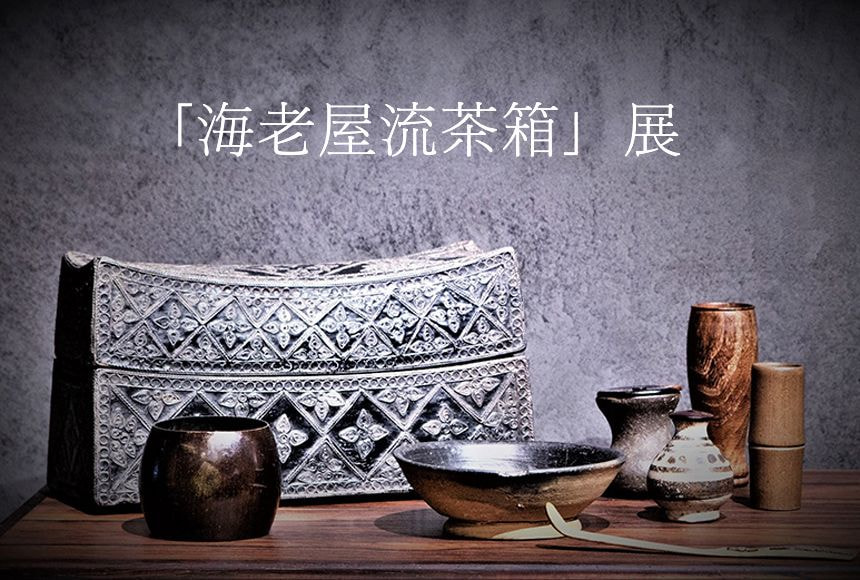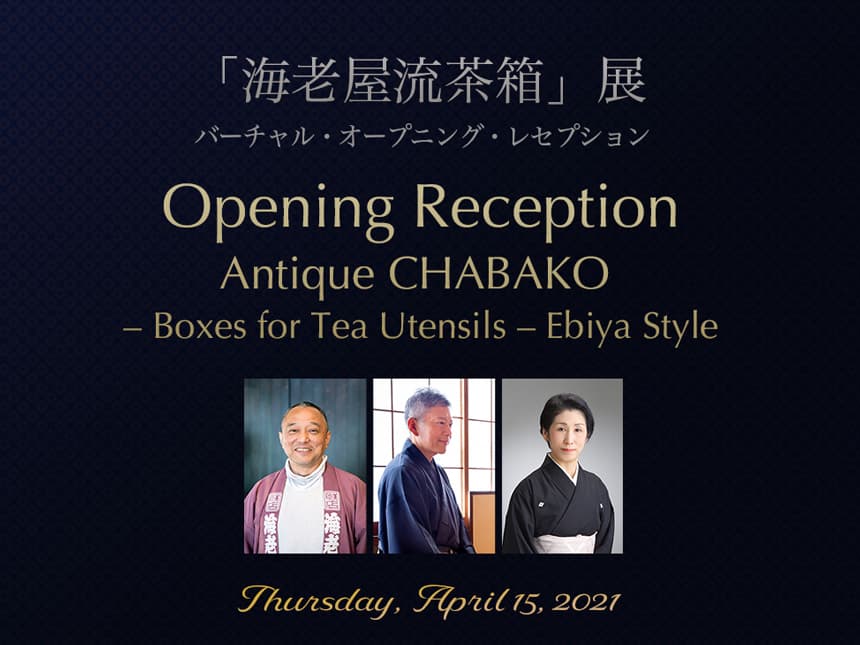
| タイトル | 日本クラブWEBギャラリー「海老屋流茶箱展」 |
|---|---|
| 開催日時 | 2021年4月15日〜 |
| オープニングレセプション | 2021年4月15日 7pm〜8pm 参加費無料 先着500名樣まで お申込みはこちら |
| 主催 | The Nippon Club |
| 協賛 | The J.C.C. Fund (Japanese Chamber of Commerce and Industry of New York, Inc.) |
| 監修 | 三宅正洋(海老屋美術店9代目当主) |
| キュレーター | 林祥子 |
茶箱は、今から約400年前に、千利休が野外でお茶を愉しむために、小さな茶道具を仕組んだのが始まりと言われています。大きさにして、長さ約20cm、幅15cm、高さ15cmほどの小さな箱のなかに、お茶を点てるための必要な茶道具、棗や茶筅、茶碗などがすべて入ってるセットのことを指します。お湯さえあれば、おいしいお抹茶が何時でも何処でも楽しめる、それが茶箱の醍醐味です。
茶道には、本来茶道用として作られたお道具でないものを、お点前に活用し、その趣向を楽しむ文化があります。千利休が、船の出入りする潜り口を茶室のにじり口に採り入れ、捕った魚を入れる魚籠や、水筒として使っていた瓢を花入に見立てたことによって、茶の世界の「見立て」がはっきりと意識されるようになったと言います。
本展では、延宝元年(1673年)から続く骨董店海老屋の九代目三宅正洋氏の「見立て」で作られた遊び心満載の茶箱をご紹介致します。お花見用に組み合わされた茶箱、お月見用に組み合わされた茶箱、そして江戸時代に日本橋と縁の深かったオランダにちなんだ茶箱など、三宅氏の見立てで選ばれた愉しい茶箱です。希少価値のある古美術・古道具を次世代へ続けていくという心意気で、20年の歳月をかけて組み合わせられた<骨董茶箱>30組をご覧下さい。

「海老屋」9代目主人の三宅正洋氏に骨董茶箱についてお話を伺った後、表千家教授中澤宗寿氏の男点前をご覧頂きます。そして、西川流宗家家元西川扇蔵十世(人間国宝)の長女西川祐子氏による日本舞踊をお楽しみ頂きます。日本舞踊題目は「お江戸日本橋」。海老屋美術店が明治維新後に京都から江戸へ移ってきた歴史にちなんで、本展のために西川祐子が創作しました。日本橋から京都への道のりを表現した西川祐子の日本舞踊を長唄三味線の音色と共にお楽しみ下さい。
三宅正洋(みやけ まさひろ)
1962年、日本橋室町の店舗兼住居にて生まれ育つ。大学卒業後に美術商としての修行を積み、現在に至る。海老屋美術店は延宝元年(1673年)に京都で創業以来、330余年続く老舗。創業期は社寺仏閣に、そして幕末期には御所に蒔絵や漆器などの調度品を納めていた。明治維新の際、天皇陛下の上京に従い、店も明治4年(1871年)に京都から東京・日本橋へと移転。大正時代から古美術も手掛けるようになり、戦後は古美術や近代絵画などを扱う美術店として展開してきた。
海老屋美術店 https://e-ebiya.com
中澤宗寿(なかざわ そうじゅ)
1970年生まれ、東京都出身。「茶の湯」「日本舞踊」「歌舞伎」の伝統芸能の家系に育つ。(大叔父歌舞伎俳優三代目河原崎権十郎。大叔母 日本舞踊吾妻流宗家。) 語学力を活かして、2000年より海外での茶会や講演活動を始める。国内では学校教育にて講義を通じて、伝統文化の魅力を伝える。
西川祐子(にしかわ ゆうこ)
六歳より父・十世西川扇蔵に手ほどきを受ける。二十二歳より花柳茂香師に師事。“祐子の会”を主催する他、えんの会、NHKや国立劇場主催公演等に出演。また平成二十六年より祐子のしおり、研修会“日本舞踊彩”西川流稽古場で催す等、普及活動にも尽力している。日本舞踊振興財団評議員、川村学園大学非常勤勤務講師、大妻日本舞踊クラブコーチ。“むすびの会”理事。文化庁芸術優秀賞など受賞。振付作品に「井筒」「あらべずく」「風や」「道成寺」など。
西川流 https://nishikawaryu.jp/ja/

| Title | The Nippon Club Web Gallery |
|---|---|
| Date | 2021.4.15 - |
| Opening Reception | 2021.4.15 7pm - 8pm Free of charge up to 500 people, First come, first served Register Here |
| Organizer | The Nippon Club |
| Sponsor | The J.C.C. Fund (Japanese Chamber of Commerce and Industry of New York, Inc.) |
| In cooperation with | Masahiro Miyake |
| Curator | Shoko Hayashi |

Mr. Masahiro Miyake will talk about “Antique Chabako”. After that, there will be a presentation of the tea ceremony by Mr. Soju Nakazawa, an Omotesenke school teacher. The reception also features a traditional Japanese dance performance by Yuko Nishikawa, the eldest daughter of a Living National Treasure, Senzo Nishikawa. She is the 10th generation head of the Nishikawa-Ryu (Nishikawa-style) school of traditional Japanese dance. She will perform her original dance, “Oedo Nihonbashi,” accompanied by Nagauta shamisen (shamisen-accompanied traditional singing). It was created to commemorate the history of the Ebiya art store, which was moved from Kyoto to Edo at the time of the Meiji Restoration. Please enjoy the road from Nihonbashi to Kyoto with Ms. Nishikawa’s dance performance and Nagauta shamisen’s sound.

